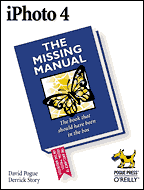
| Home |
| Join/Renew Online! |
| About NCMUG |
| Membership |
| Newsletter |
| Special Interest Groups |
| Mail Lists |
| Volunteering |
| Book Library |
| Member Sites |
| NCMUG FAQs |
| Mac FAQs |
| Contact Us |
| Site Map |

 iPhoto
4: the Missing Manual necessary?
iPhoto
4: the Missing Manual necessary?

by David Pogue & Derrick Story
Retail Price: $24.95
ISBN: 0-596-00692-6
Pages: 352
User-friendly interfaces are the norm in Apple's iApps. Most mac users could fire up iPhoto 4 for the first time and click around until the basic functionality becomes clear. So why is iPhoto 4: the Missing Manual necessary?
Woefully inadequate online help is also common in the iLife series of media applications. If you want to use iPhoto 4 to the fullest and explore the many ways of sharing your masterful photography with others, I recommend this book as your guide. There's more to iPhoto 4 than meets the intuitive eye.
iPhoto 4's new features are explained in the usual excellent Missing Manual style - a style just as user-friendly as the application itself. Let's just come right out and say it. Most of us need friendly step-by-step advice when venturing into procedures that we have not tried before. And such advice is crucial when trying out a usage we haven't even thought about.
Thinking about publishing one of those cool photo albums right out of the iPhoto Book tab? Want to stretch your media muscles by taking the slide show function to new levels - maybe even transitioning over to iDVD and burning an interactive disc with multiple slide shows?
This book guides you easily through all of these features, as well as the new-to-iPhoto 4 ones in depth. Now there is much more to utilize and therefore, a lot more to learn. You can still thrill at the tactile experience of growing and shrinking your thumbnails with the slider bar. But new improvements such as Smart Albums, increased capacity, and speeded-up operation make iPhoto 4 a more popular application for photographers than before. The structural updates beg for concise documentation.
And no better concise documenters exist than the authors, Derrick Story and David Pogue. Mr. Story, the photographer's photographer, and Mr. Pogue, the master of translating geek-speak into instruction for the rest of us, are a great team to dissect this iApp. No sugar coating here, just plain talk. For instance, in the Troubleshooting section, topics include, "iPhoto is doing something bizarre," and "iPhoto is wigging out." The authors acknowledge that iPhoto 4 is less crash-prone and sluggish than previous versions, although as they put it, "Lightening does strike." Luckily their tips get you out of the woods.
All levels of experience are covered in the book. Part One is a must-read for anyone who wants to make an educated decision about which digital camera to buy. Derrick Story's practical advice in getting great shots is included in the "Beyond the Simple Snapshot" chapter, including tips and tricks that are easy to try and will help amateur digital shooters get professional results.
Part Two is a welcome time
saver when you run out of intuitive steam while clicking around the interface.
Readers of the Missing Manual that master this section will have no trouble
zooming through the application's secrets with confidence. iPhoto
4's structure is a logical digital shoebox that needs some study
before one can boldly dump precious original photos into the great data
beyond - and be able to retrieve them, organize them, and set up
automatic filing procedures.
You can pick up the book at any point that suits your expertise and start learning. Let's say you have mastered digital shooting, editing, and using iPhoto's auto features of organization. Then you might be ready to share your images in many different digital ways. Enter Part Three. Part Three has explanations on the sharing processes of slideshows, printing, email, web publishing, photo books, QuickTime and iDVD slideshows. I found these so comprehensive that my projects of photo books, QuickTime movie slideshows and homepage web galleries became frustration-free exercises to produce.
"iPhoto Stunts" is the intriguing name of Part Four. I am not a fan of cameraphones or stunts with these hybrid toys, which is in all fairness a small part of this Section. However, the other info about producing screen savers, converting pictures, and utilizing AppleScripts is very useful. And then, at last, everything you always wanted to know about backing up iPhoto 4 but were afraid to ask. Reading the chapter on iPhoto 4 file management is an absolute necessity in getting you to understand the somewhat arcane architecture of iPhoto 4 and where it stores your photos.
Want to manage multiple photo libraries? Merge them, swap them, burn CD's and DVD's of them, or share them on a network? It's all here in understandable prose. Leave the professional image editing to Photoshop. For everything else there's iPhoto 4 and it's trusty sidekick, The Missing Manual.
Review by NCMUG member John Hershey